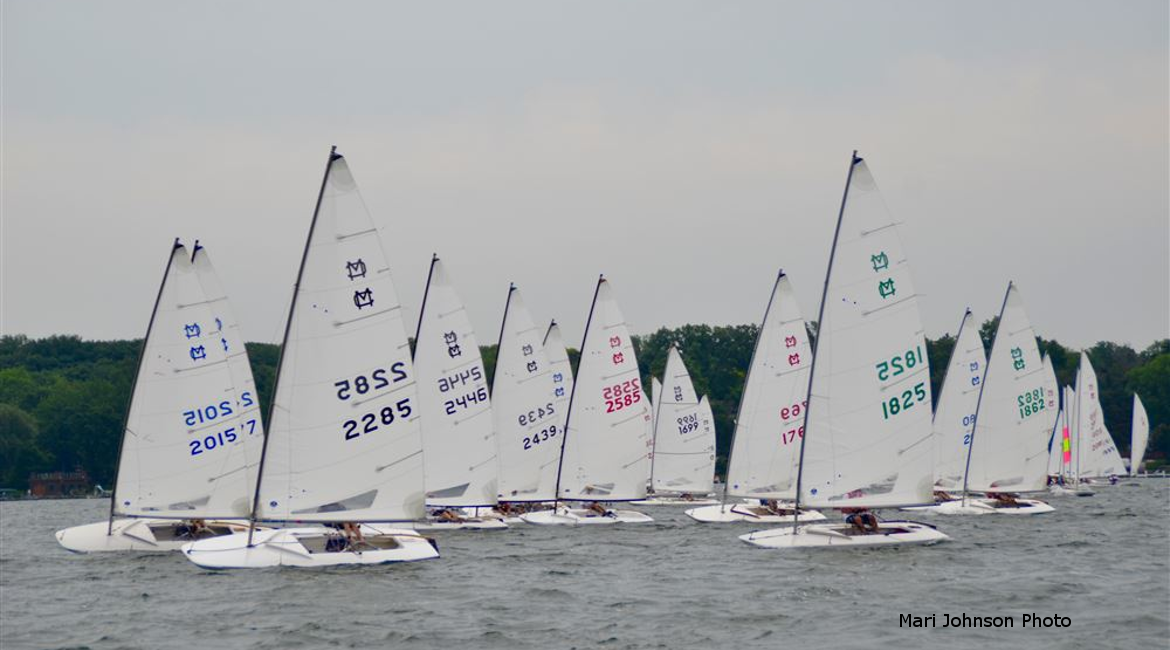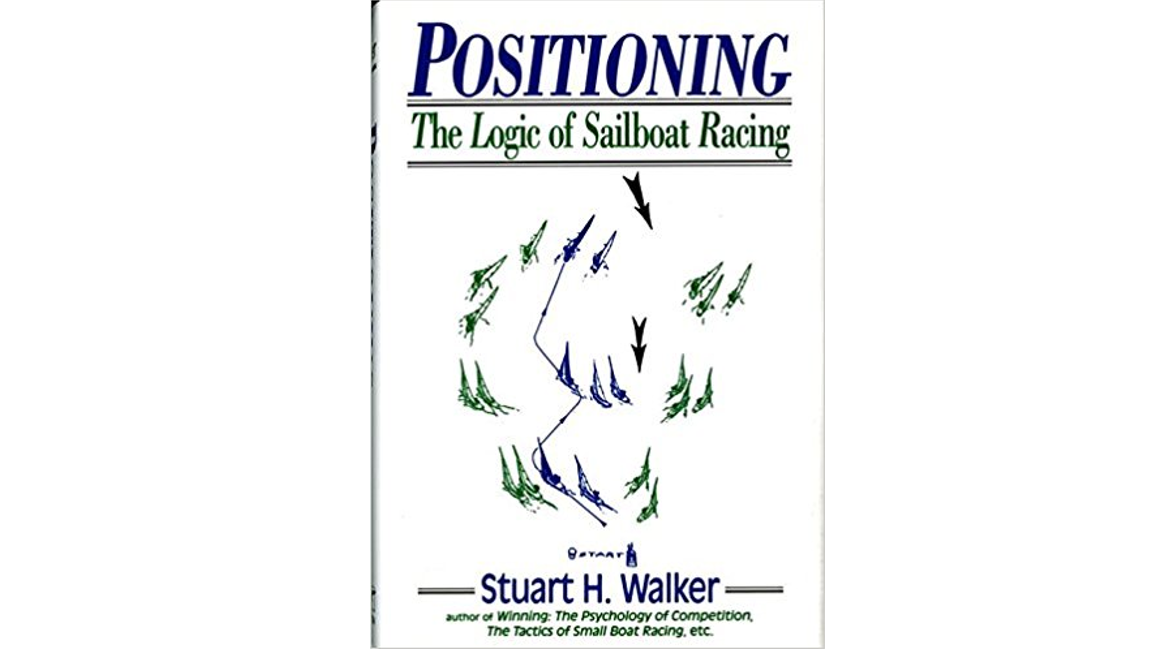How’s your sense of geometry on the race course? Can you make quick and accurate judgments about laylines, who’s ahead, and the direction of the wind? Tacking lines can help. In this post, we discuss the geometry behind tacking lines and suggest how you might adapt a practical version of the concept for small boat sailing.
Tacking lines show you three key directions when sailing upwind: 1) the true wind direction, 2) the direction of the “ladder rung” you’re on, and 3) the direction you’d be heading on the opposite tack. Knowing these directions helps you make better strategic and tactical decisions.
In issue #81 of Speed & Smarts, Dave Dellenbaugh shows how to use tacking lines to their fullest extent. We’ve attached his guidance here (PDF download), with permission. Dave’s explanations and drawings are clear and worth reading, even if you never install tacking lines.
In the sections below, we’ll summarize the key concepts and suggest a simplified method for using them.
Tacking Angle
Assume you have a compass on your boat, and are sailing close-hauled on starboard tack in a due north direction (compass heading 000°). What would the compass read if you tacked and sailed close-hauled on port? The answer depends on your tacking angle. For many boats in light to medium air, the compass might read 090° after the tack. If so, your tacking angle is 90°.
Tacking angles vary widely based on the boat, the wind speed, and the ability of the skipper to sail the boat for best upwind performance. For most boats, in very light wind you’ll tack through an angle of 95-100° or perhaps more. In strong wind, you could tack through an angle of as little as 70-75°.
Even if you never install tacking lines, you should have a feel for your tacking angle in different conditions. It’s very frustrating to think you’re sailing on a header, tack, and then find out you’re pointing further away from the mark! Similarly, you may think you’re sailing a lift, but get forced to tack and find out you’re more lifted on the new tack! Avoid both of these errors by knowing your tacking angle for various wind conditions.
Three Key Direction Lines and Their Uses
Based on your tacking angle, you can deduce three key directions when sailing upwind. These are shown in the drawing below for a 90° tacking angle.

True Wind
The true wind direction is halfway between your headings on port and starboard. For a 90° tacking angle, the true wind is 45° off your windward bow. In less wind, it might be 50° off your bow or more. In stronger wind, it might be only 35-40° off the bow.
Visualizing the true wind direction is helpful:
- Lifted tack. Compare the true wind direction to the course rhumb line to get a feel for whether you’re on the lifted tack. This is a better method than comparing the distance of your bow from the mark, since it doesn’t depend on your position on the course. This method also helps when you can’t rely on compass readings, due to a major direction shift.
- Anticipate lifts and headers. Compare the motion of an oncoming puff to the true wind. If the puff is coming from forward of the true wind, it’s a header, and vice versa.
Ladder Rung
Ladder rungs indicate how far upwind you have progressed. See our post on Ladder Rungs for the theory behind this.
The ladder rung direction is always 90° to the true wind. If your tacking angle is 90°, the ladder rung direction is 45° to off your leeward bow. In stronger wind it will be more than 45° to leeward of the bow. The ladder rung line extends in both directions from the boat – to leeward and ahead and to windward and behind.
Visualizing ladder rungs helps you answer two important questions:
- Am I ahead or behind? If other boats are behind your ladder rung line, you’re ahead. Use this to check boats at a distance, as well as those closer to you.
- Can I cross?
- Boat to leeward on opposite tack. If the other boat is behind your ladder rung, you should be able to cross, assuming you leave enough extra to clear the other boat’s bow.
- Boat to windward on the same tack. If the other boat is behind your ladder rung (extended over your shoulder), you should be able to tack and cross, assuming you leave extra room for the tack.
Opposite Tack
Your heading after tacking will change by the amount of your tacking angle. Having a line to visualize this is helpful. For a 90° tacking angle, your boat’s center traveler, or any similar athwartship line, shows you where your bow will point after tacking. In stronger wind, the new direction will be forward of 90°; in light air it will be behind.
- Layline. Visualizing the opposite tack direction helps you find the layline. Missing layline calls quickly costs you places. See our post on Layline Calls for more.
- Tacking too far. If you have a problem with tacking too far, use this line to find a shore reference to end the tack.
Simplified Tacking Lines for Small Boats
You don’t see tacking lines in small single- or double-handed boats. The skipper is usually the tactician and it’s hard to place them so he/she can sight along the lines. Also, having lines for different tacking angles makes them hard to decipher at a distance. To see the potential complexity in full-featured tacking lines, look at the template in Dellenbaugh’s article. This led us to think about a simpler, skipper-friendly option.
Layout
To reduce the number of lines, we opted for a layout that shows the true wind and ladder rung lines for only a 90° tacking angle (TA). We placed these forward, in the skipper’s line of sight. If the TA is smaller or larger than 90°, the skipper can visually fudge the lines as needed.
For the opposite tack lines, we opted for three lines on each side showing the maximum, minimum, and 90° TAs. We placed these near the skipper position. Three lines will help get a more accurate layline call based on the conditions.
Here’s the potential layout. To install lines, string a reference line down the centerline of the boat and use a protractor. Place the lines on the deck with a marker or adhesive pin-stripe tape. You can adjust them as needed.

Usage
The drawing below shows how to use the lines. With practice, you’ll quickly get used to looking for the appropriate line to use.

Championship Tactics, by Gary Jobson and Tom Whidden – discusses tacking lines in Ch. 11




